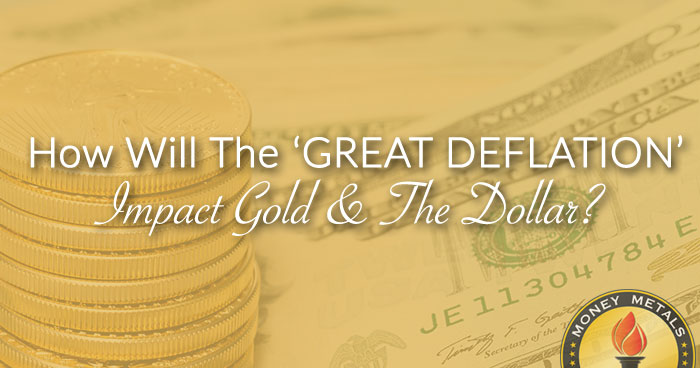The coming GREAT DEFLATION will impact the value of Gold and the Dollar much differently than what most analysts are forecasting. Unfortunately, most analysts do not understand the true underlying value of gold or the U.S. Dollar, because they base their forecasts on information that is inaccurate, flawed, or imprecise.
This is due to two faulty theories:
- monetary science
- supply-demand market forces
While some aspects of monetary science and supply and demand forces do impact the prices of goods and services (on a short-term basis), the most important factor, ENERGY, is overlooked. You will never hear Peter Schiff include energy when he talks about the Federal Reserve, Commercial Banks, money printing, or debt. Schiff, like most analysts, is stuck on studying superficial monetary data that does not get to the ROOT OF THE PROBLEM.
Furthermore, the majority of folks who believe in the Austrian School of Economics, also fail to incorporate ENERGY into their analysis. For some strange reason, most analysts believe the world is run by the ENERGY TOOTH FAIRY (term by Louis Arnoux). Without cheap and abundant energy, monetary science and supply-demand forces are worthless.
That being said, as the debate on whether the world will experience, inflation, hyperinflation or deflation will continue to go on and on, I guarantee we are going to experience the MOTHER of all DEFLATIONS. Again, this will be due to the disintegrating energy sector and its inability to provide sufficient profitable net energy to the market.
The falling net energy and declining EROI – Energy Returned On Investment, are gutting the entire market. This can be seen quite clearly as the U.S. added $4 of debt for each $1 of GDP growth in 2016. According to the Zerohedge article, It Took $4 In New Debt To Create $1 In GDP:
As a reminder, according to the latest BEA revision, the nominal 2016 GDP was $18.86 trillion, an increase of $632 billion from 201, the question is how much credit had to be created to generate this growth. Well, according to the Z.1, total credit rose to a new record high of $66.1 trillion. This was an increase of $2.511 trillion in the past year. It means that in 2016, it “cost” $4 in new debt to generate just $1 in new economic growth!

As we can see, adding $4 of debt to create $1 of artificially inflated GDP is not a long-term sustainable business model. I get a laugh hearing “Conspiracy Theorists” explain how the ELITE has been planning this take-over all along and has the markets totally under control. While conspiracies do indeed take place, the ELITE have been SHOOTING FROM THE HIP and WINGING IT just to keep the entire market from imploding.
For those who believe that the elite wants to crush the market to buy assets for pennies on the Dollar, I am here to tell you... it CHAIN’T gonna happen. When the Ancient Roman Metropolis collapsed from a population of one million people down to 12,000, I can assure you, the majority of the ELITE were wiped out... KAPUT.
Real Estate values and revenue streams in Ancient Rome evaporated into thin air. There was no “RECOVERY” or “PLAN B.” Death had come to the once great Roman Empire... for good.
Regardless, the coming GREAT DEFLATION will destroy the value of most assets shown in the chart below:

Of the $369 trillion in global asset values (2015), gold and silver accounted for $3.1 trillion or 0.8%. That’s correct, not even 1% of total global assets. Savills Research, who put together the data shown in the chart above, recently published figures on Global Real Estate Investment:

Now, this chart does not represent total Real Estate values but rather shows how much money is being invested in the Global Real Estate Market (minus China). Interestingly, global real estate investment has never regained its previous peak set back in 2008. Furthermore, the data show that global real estate investment has rolled over and declined since the first quarter of 2016. This is not a good sign.
This means deflationary forces may already be taking place in the global real estate market.
How The ‘GREAT DEFLATION’ Will Impact Gold & The Dollar
To understand how the coming GREAT DEFLATION will impact gold and the U.S. Dollar, we must throw out the window all preconceived notions about economics and money. Any individual who continues to believe in the standard orthodox economic theory, you might as well also accept that the EARTH IS FLAT and GROWTH on a finite planet is possible.
Unfortunately, the U.S. educational system and alternative media continue to misinform the public about the role of MONEY. So, the blind continue to lead the blind as Rome burns… so to speak.
The GREAT DEFLATION is coming due to the disintegration of the U.S. and global oil industry. As I mentioned in a previous article, the top three U.S. oil companies slashed their Q1 2017 capital expenditures (CAPEX) by 40%, versus the same period last year. Furthermore, the world only found 2.4 billion barrels of new oil in 2016 while it consumed 25 billion barrels:

I hate to be a broken record, but precious metals investors better WAKE UP. How many new barrels of oil do you think the global oil industry will find in 2017 as they continue to slash their CAPEX spending even greater than last year??
Regardless, the Fed and Central Banks are propping up the market with more money printing and asset purchases than ever. This will not solve our financial and economic problems, however, it is a last-ditch effort to postpone the inevitable.
To truly understand what will happen with the value of Gold and the U.S. Dollar, we have to grasp the data shown in the chart below:

To produce an ounce of gold in 2016 (top two gold miners – Barrick & Newmont), it took $1,113. Thus, the top two gold miner’s total production cost was 89% of the gold market price ($1,251). This is why gold stores wealth. Stored wealth has always been “STORED ECONOMIC ENERGY.” Gold has been the King Monetary Metal because of its rarity in the earth’s crust and its ability not to corrode or tarnish like many other metals.
On the other hand, the U.S. Treasury Department of Engraving and Printing produced a new $100 bill for a mere 13.4 cents. Thus, the U.S. Treasury’s $100 bill cost of production was 0.13% of its face value, versus 89% for an ounce of gold.
The production cost figures for the U.S. Federal Reserve Notes came from the U.S. Treasury Department of Engraving and Printing, shown in the table below:

It cost the U.S. Treasury $134.14 per thousand $100 bills printed. While the U.S. Treasury spent more money to produce the lower denomination bills versus their total face value, 71% of the $213 billion of Federal Reserves Notes printed in 2016 were $100 bills.
If we can understand the information presented above and can do some “CRITICAL THINKING,” then it is easy to understand that the U.S. Dollar will suffer significantly during the GREAT DEFLATION….. not gold.
We also must remember, a “NOTE,” as in the “Federal Reserve Note,” means an “OBLIGATION” or “DEBT.” Money is not supposed to be an obligation or debt. Money is supposed to be a store of value and a medium of exchange.
Thus, when the GREAT DEFLATION arrives, the value of the U.S. Dollar has a much farther way to fall versus gold. Why? Because the value of most things, always reverts to their COST OF PRODUCTION. The innate value of a $100 bill is a mere 13.4 cents…. so, its value still has room to fall 99%+.
Again… the innate value of most things is based upon their cost of production, not supply and demand. What’s the use of being in the business of producing goods at a loss????
Here is one last example. In 2016, the total global gold mine supply was worth $103.6 billion. This figure was based on the 3,222 metric tons of gold mine supply (GFMS 2017 World Gold Survey), multiplied by the average spot price of $1,251. The estimated cost to produce this gold was $92.2 billion:

Here we can see that the gold market price was based on its cost of production. On the other hand, the U.S. Treasury was able to print $151.7 billion in $100 bills for a total cost of $235 million ($0.235 billion). This means the U.S. Treasury’s production cost was only 0.13% for the $151.7 billion of new currency (fake money) it issued last year.
People need to realize the U.S. Dollar’s value is backed by U.S. debt, which is being propped up by burning energy. Thus, ENERGY = MONEY. The huge increase in U.S. and Global Debt means the quality of energy that runs everything is rapidly declining. This means, the more debt that is added, the lower interest rates have to go. It is a one-way street.
Analysts who think interest rates need to normalize to a much higher level have no idea about ENERGY…. ZIP, NADDA, ZILCH. They look at the markets as if the ENERGY TOOTH FAIRIES run everything. There are only a small handful of analysts who understand the energy dynamics. The rest are the blind leading the blind.
Is Deflation Good?
The coming GREAT DEFLATION will destroy the value of most STOCKS, BONDS, REAL ESTATE, and PAPER CURRENCIES. The reason Real Estate prices will plummet below their cost of production is due to their 20-30 year financing and their inability to function during the disintegrating energy environment. The same will be for automobiles and many other assets and items.
Investors need to understand how ENERGY and the FALLING EROI- Energy Returned On Investment, will impact the value of most assets going forward. Most assets will collapse in value, while a few will hold or gain in value. Gold and silver will be two of the few that will hold or gain in value during the GREAT DEFLATION.

About the Author:
Independent researcher Steve St. Angelo started to invest in precious metals in 2002. In 2008, he began researching areas of the gold and silver market that the majority of the precious metal analyst community has left unexplored. These areas include how energy and the falling EROI – Energy Returned On Invested – stand to impact the mining industry, precious metals, paper assets, and the overall economy.






